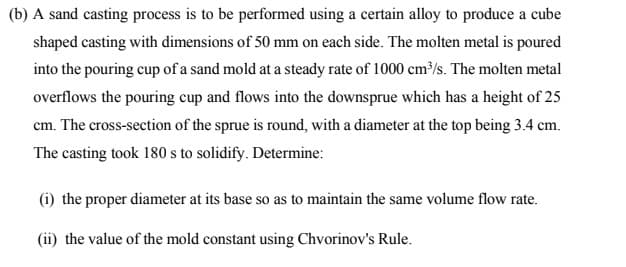b) A sand casting process is to be performed using a certain alloy to produce a cube shaped casting with dimensions of 50 mm on each side. The molten metal is poured into the pouring cup of a sand mold at a steady rate of 1000 cm/s. The molten metal overflows the pouring cup and flows into the downsprue which has a height of 25 cm. The cross-section of the sprue is round, with a diameter at the top being 3.4 cm. The casting took 180 s to solidify. Determine: (i) the proper diameter at its base so as to maintain the same volume flow rate.
b) A sand casting process is to be performed using a certain alloy to produce a cube shaped casting with dimensions of 50 mm on each side. The molten metal is poured into the pouring cup of a sand mold at a steady rate of 1000 cm/s. The molten metal overflows the pouring cup and flows into the downsprue which has a height of 25 cm. The cross-section of the sprue is round, with a diameter at the top being 3.4 cm. The casting took 180 s to solidify. Determine: (i) the proper diameter at its base so as to maintain the same volume flow rate.
Principles of Heat Transfer (Activate Learning with these NEW titles from Engineering!)
8th Edition
ISBN:9781305387102
Author:Kreith, Frank; Manglik, Raj M.
Publisher:Kreith, Frank; Manglik, Raj M.
Chapter6: Forced Convection Over Exterior Surfaces
Section: Chapter Questions
Problem 6.12P
Related questions
Question
Manufacturing Processes.

Transcribed Image Text:(b) A sand casting process is to be performed using a certain alloy to produce a cube
shaped casting with dimensions of 50 mm on each side. The molten metal is poured
into the pouring cup of a sand mold at a steady rate of 1000 cm/s. The molten metal
overflows the pouring cup and flows into the downsprue which has a height of 25
cm. The cross-section of the sprue is round, with a diameter at the top being 3.4 cm.
The casting took 180 s to solidify. Determine:
(i) the proper diameter at its base so as to maintain the same volume flow rate.
(ii) the value of the mold constant using Chvorinov's Rule.
Expert Solution
This question has been solved!
Explore an expertly crafted, step-by-step solution for a thorough understanding of key concepts.
This is a popular solution!
Trending now
This is a popular solution!
Step by step
Solved in 2 steps

Knowledge Booster
Learn more about
Need a deep-dive on the concept behind this application? Look no further. Learn more about this topic, mechanical-engineering and related others by exploring similar questions and additional content below.Recommended textbooks for you

Principles of Heat Transfer (Activate Learning wi…
Mechanical Engineering
ISBN:
9781305387102
Author:
Kreith, Frank; Manglik, Raj M.
Publisher:
Cengage Learning

Principles of Heat Transfer (Activate Learning wi…
Mechanical Engineering
ISBN:
9781305387102
Author:
Kreith, Frank; Manglik, Raj M.
Publisher:
Cengage Learning